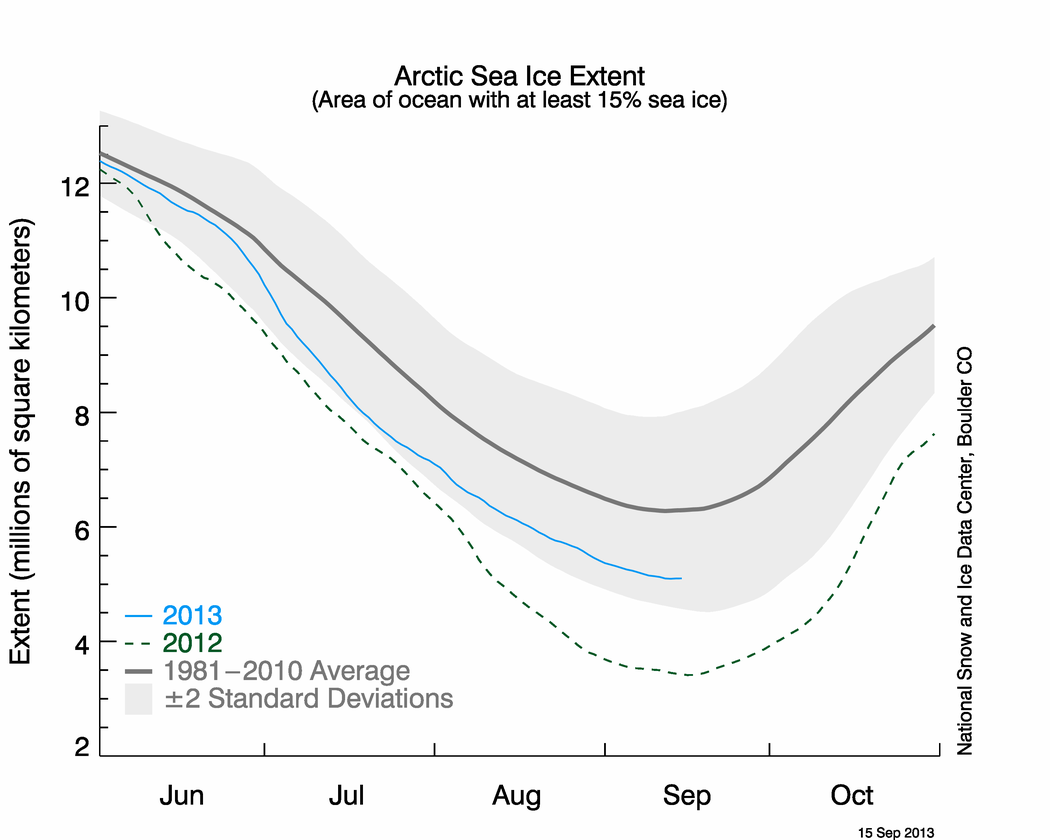In the next few days the Arctic sea ice will reach its minimum extent for 2013. At the end of this year’s summer melt season, the areal extent covered by sea ice was more than a million square kilometers below the 30-year average. That’s a lot of ice missing compared to an average year. An area of frozen ocean—ten times the size of Indiana, or four times the size of Colorado, or a third bigger than Texas—is just not there this summer.
While this is shocking and part of a several-decade decline in Arctic sea ice, what’s also alarming is the lack of substantive media coverage. The decline in Arctic sea ice should concern all of us in the same way that a collapse of the economic system does. It deserves front page billing. A recent Nature commentary stated that “the costs of a melting Arctic will be huge, because the region is pivotal to the functioning of Earth systems such as oceans and the climate.” They don’t mince their words.
Not only has the extent of sea ice been declining since satellite measurements began in the 1970s, but the volume has also decreased dramatically. The volume of Arctic sea ice in August 2013 was less than a third the volume it was in August 1979. Source: Andy Lee Robinson
Here are five reasons why the decline of the Arctic sea ice matters:
1. Sea ice reflects sunlight, keeping earth cool
When bright, reflective sea ice melts, it gives way to a darker ocean. More heat is absorbed by a darker surface, leading to more warming. This is known as the ice-albedo feedback effect. Largely due to the recent dramatic loss of sea ice and this feedback, the Arctic is now warming at twice the global rate.
2. Sea ice forms a surface barrier, moderating winter weather
Sea ice covers the ocean for much of the year, impeding the transfer of heat and moisture from the ocean to the atmosphere. With less sea ice extent and thinner sea ice becoming common, there is a greater transfer of both moisture and heat to the atmosphere in the Arctic. Combined with the ice-albedo feedback, this amplifies the region’s warming, and may affect circulation patterns like the jet stream, that can affect weather patterns in the lower 48 states and elsewhere.
3. Sea ice influences the ocean conveyor belt
As sea ice forms in the Arctic and Antarctic, dense salty water sinks to the bottom of the ocean starting the “global ocean conveyor belt” that pumps heat and salt around the world’s oceans. The flow of this water helps regulate temperature and distributes nutrients throughout the oceans. It is crucial to the oceanic food chain and takes hundreds of years to complete a full circuit. The “conveyor belt” helps keep places like London temperate even though they are further north than much colder cities like Boston.
4. Indigenous communities rely on sea ice for their culture and livelihoods
For many indigenous communities sea ice affords protection from waves and coastal erosion, provides a surface for distant travel, a habitat for birds and animals they hunt, and forms a central part of spiritual beliefs. The ecosystem services from sea ice that indigenous communities depend on are diminishing. Along with that, the world is losing the expert knowledge and the physical locations of cultures with an intimate connection to the Arctic.
5. Sea ice affects both land-based and ocean-based ecosystems
The ecological consequences of changes in Arctic sea ice are outlined in a recent paper in Science here. Sea ice determines the interaction between marine and terrestrial species, influences ocean productivity, and affects local weather. From phytoplankton at the base of extensive food chains to potent heat-trapping methane release from permafrost, changes to natural systems will come at great financial and ecological cost.
Loss of Arctic summer sea ice – not “if” but “when”
As the relentless decay of sea ice continues, an ice-free summer in the Arctic is a given – it’s now a matter of “when,” not “if”. Nine of the lowest years on the satellite record for Arctic sea ice minimum extent have been in the last decade. But we do have a choice – we must act swiftly to reduce emissions and ensure we avoid the very worst impacts to the fragile Arctic ecosystem. We can and must try to delay the disappearance of summer sea ice and time is of the essence.
Front page image courtesy of Richard Petry.

